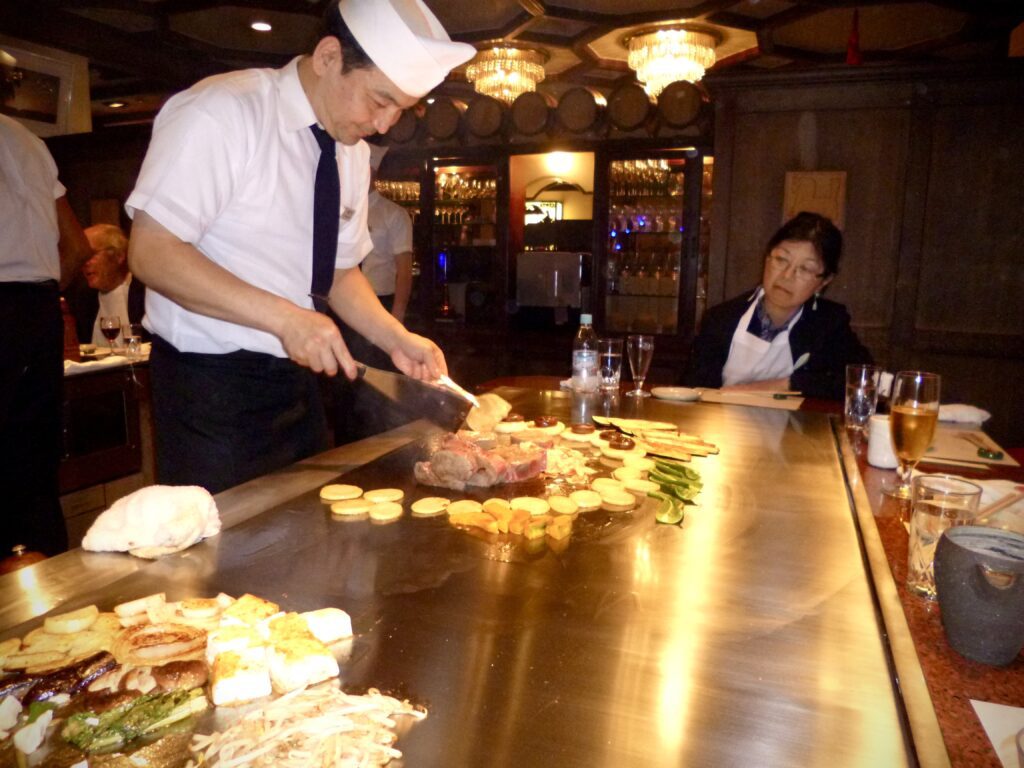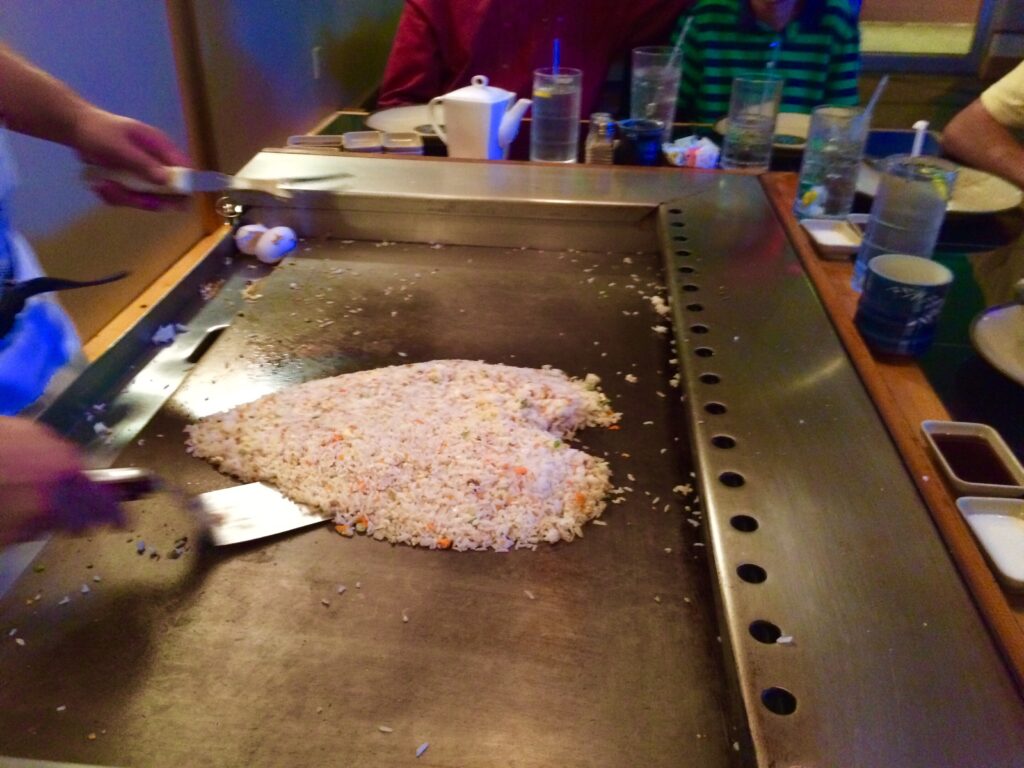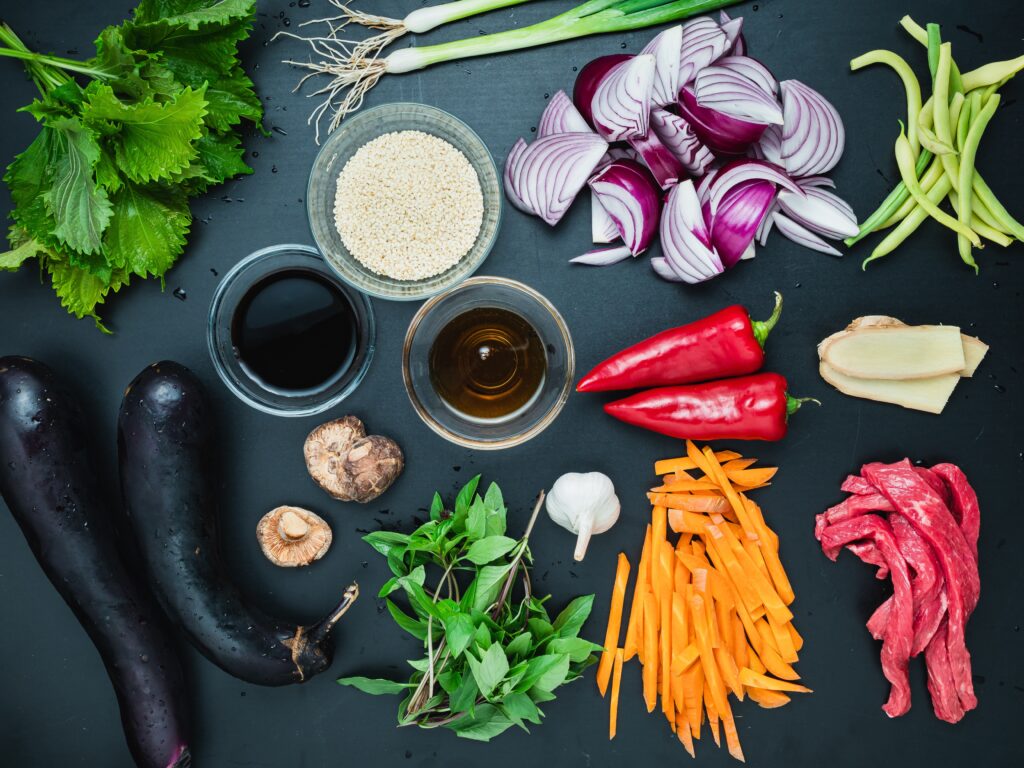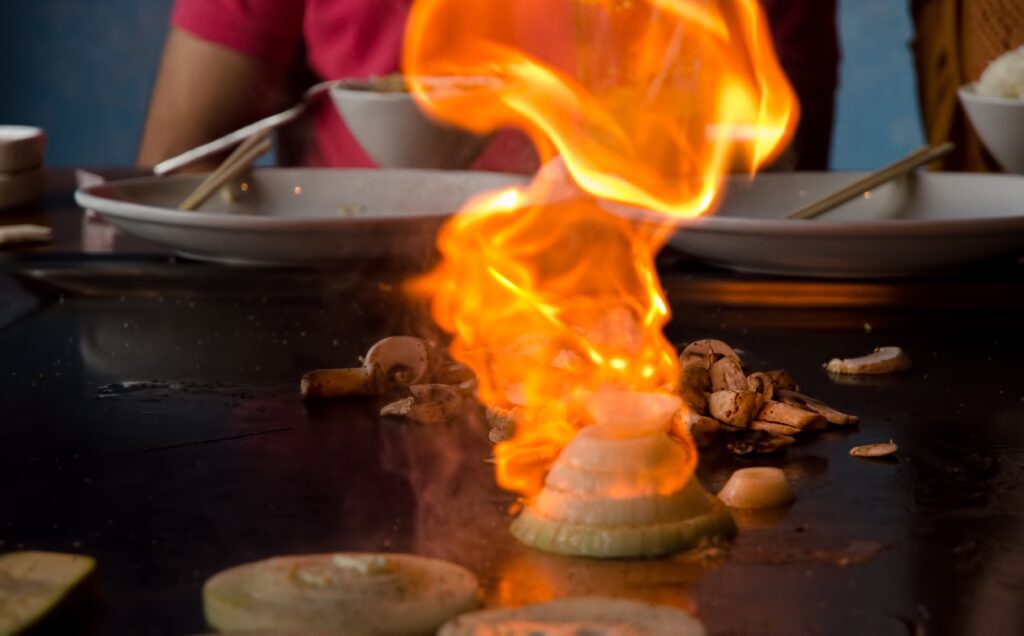What is Teppanyaki
Teppanyaki is more than just a style of cooking. It’s an experience that combines culinary mastery with theatrical flair. Originating in Japan, Teppanyaki has become a worldwide phenomenon, enchanting diners with its sizzling grills, precision knife work, and the skillful artistry of chefs who prepare your meal right before your eyes.
While it may just be a style of cooking like BBQ or Stir-Fry, it’s the performance by well-trained teppanyaki chefs that sets it apart from all other styles. How many other restaurants do you see someone cooking directly in front of you?
We’d like to take this opportunity to show you a little history of Teppanyaki from how it got its start in Japan, to its arrival in the United States, and some of the differences between Japanese and Western-style Teppanyaki.
What Does Teppanyaki Mean?
To start, let’s answer this first question: What does teppanyaki mean?
Teppanyaki (tuh·paan·yuh·kee) is derived from the word “teppan” in Japan, which means metal plate. “Yaki” means grilled, fried, and pan-fried. So, the literal translation would be grilling or frying on a metal plate.
It is commonly used interchangeably with the term hibachi, but they are two different styles of cooking. While both styles showcase live cooking, Teppanyaki focuses on individual or small group dining, whereas hibachi is often a communal and interactive dining experience.

History of Teppanyaki
Teppanyaki started over 200 years ago in Japan. While some believe it began in their steak houses, other historians claim it is rooted in Japanese homes. They would prepare stir-fried noodles for their families long before it became a popular dining attraction.
The dining experience was commercialized in 1945 when Misono, based in Kobe, Japan opened its doors. Shigeji Fujioka, one of the chefs at Misono, is said to be the origintator of the modern style of teppanyaki. The chefs at the restaurant dazzled their guests with sizzling grills, precision knife work, and the skillful artistry of preparing a meal right before their eyes.
While fun and inventive, teppanyaki was not as popular with native Japanese people. However, they were extremely popular with foreign tourists. Westerners would come from all corners of the world to experience the new dining craze as told to them by businessmen in their foreign travels.
So much so, it led to its…
Arrival in America
Teppanyaki came to the United States in the early 1960s. The first restaurant was opened in New York City, offering American diners a fusion of Japanese culinary artistry and theatrical cooking. The concept quickly gained popularity, and teppanyaki establishments soon sprang up across the country.
During this time, teppanyaki restaurants became Americanized to what they are still known as today…
Japanese Steakhouses.

Many restaurants use this moniker because it is easier to understand upon first glance, and many Americans don’t know what teppanyaki is. The concept remains the same, and Japanese steakhouses around the country have mastered the art of teppanyaki.
Now that we’ve looked at the history of teppanyaki and how it arrived in the United States, let’s get into the good part: the food.
Typical Teppanyaki Ingredients
If you’re asking “What is Teppanyaki?”, you’ll also need to know about the typical ingredients using in Teppanyaki cooking! There are two distinct styles of teppanyaki cooking, and each uses different but equally delicious types of ingredients. The Japanese style follows takes a more traditional approach, while the Western style has more American influences.

Japanese Style
Yakisoba – Japanese Stir-Fried Noodles. It is believed that this was the first food the Japanese used in cooking the original form of teppanyaki.
Cabbage – Cabbage was, and still is today, one of the most prevalent and widely used vegetables in Japan.
Sliced Meats – Many forms of meat were used like steak, seafood, and chicken. At Kobe, we also use Kobe beef, one of the finer cuts of beef. Fun Fact: A popular staple of Teppanyaki style cooking in Japan, is Kobe beef.
Western Style
Noodles or Rice – Western style trends more toward the use of rice rather than noodles because it is an easier starch to cook and perform with regularly.
Chopped Vegetables – Heavy use of onions, beans and carrots.
Sliced Meats – Beef, chicken and shrimp are the most used meats while lobster and scallops are used for specialty dishes or upon request.
You may be thinking, well these look very similar, the Western style just has more. However, there is one aspect between the two that changes the flavoring of your food.
One of the key differences between Japanese and Western style is the oil the food is cooked in. Traditional Japanese style is a combination of vegetable oil and animal fat. Meanwhile, Western style teppanyaki does not use animal fat.
Teppanyaki restaurants and chefs tend to use tasteless oil for Western-style cooking. This means the flavors of the food and spices used come through more than the taste of the oil or animal fat.
Although the above are some of the key ingredients used in Teppanyaki-style cooking, it’s worth noting that you can never go wrong by pairing your Teppanyaki food with some refreshing sake!
Now, let’s delve into how this remarkable style of cooking is performed.
How is Teppanyaki Cooking Performed?
If you’ve visited one of our restaurants, you’ve either seen the flips and fire on the grill or heard the clanging of the spatulas and the sizzle of the grill. After all, it takes some effort to make your night both delicious and entertaining.
Cooking tool Flare:
A well-trained teppanyaki chef will always start with the rhythmic drumming and captivating flipping of their cooking tools. Generally, knives and spatulas are tossed around to start the performance and wow the guests with the chef’s impressive skills.
Chopping and dicing ingredients:
At most restaurants, the prep work for the cooking is done before you even arrive in the restaurant. With teppanyaki cooking, the prep work is done right in front of you. The chefs use precision cuts and slicing styles that not only entertain their guests, but also make the food easier to prepare.
Flaming and cooking:
Of course, you have to include the cooking. The teppan is situated at the center of the patron’s vision so they can see every part of their meal cooked before their eyes. Plus, the anticipation of seeing the food right in front of you makes it taste better!

Teppanyaki vs Hibachi: What’s the Difference?
By now, you’re probably thinking, “Teppanyaki sounds a lot like hibachi!” It’s true that teppanyaki and hibachi are really similar; however, it’s a common misconception that they are the SAME thing.
So, what’s the difference between teppanyaki and hibachi grilling?
For starters, it all boils down to the type of grill the chef uses. On one hand, a hibachi-style grill is small, portable, and made from cast iron. On the other hand, a teppanyaki-style grill is more like a griddle. It is made from iron and is a long, flat surface that allows the chef to cook large quantities of food with ease.
While both cooking styles allow the chef to grill in front of guests, the teppanyaki grill is usually the type of grill you will see in restaurants found across the U.S.
Now, let’s talk about the chef.
Role of the Chef
You can’t have a delicious meal without a skillful chef! The role of the teppanyaki chef is pivotal in creating the unforgettable dining experience that this style of cooking is renowned for. These chefs are not merely cooks; they are skilled performers who bring the culinary stage to life. They undergo rigorous training, honing their dexterity with knives, precision on the grill, and the art of presentation.
But it’s not just about culinary prowess, teppanyaki chefs are also entertainers, engaging diners with their charismatic flair, humor, and captivating showmanship. As they cook ingredients to perfection before your eyes, they orchestrate a seamless performance, making every sizzle, flip, and sizzling sound a part of the dining spectacle.
Their ability to combine culinary expertise with a charismatic stage presence creates an experience that extends far beyond a mere meal. It’s a culinary journey and a live performance rolled into one!
Experience the Art of Teppanyaki at Kobe Japanese Steakhouse
As you can see, teppanyaki is more than a method of cooking. It’s a captivating culinary art that combines expertise with entertainment, turning each meal into a memorable experience. Now that you know the history behind this delicious style of cooking, come and experience it for yourself!
At Kobe Japanese Steakhouse, we’re here to make every moment sizzle with perfection. Taste and experience the extraordinary world of teppanyaki with us, where each dish is a masterpiece and every dining experience is a true delight. Book a reservation or order online with us today!